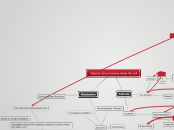Objects and processes inside the cell
Metabolism
Energy Coupled Reactions
The adenosine triphosphate cycle
Dissapitate energy from catabolic reactions is used to make ATP (ADP + Pi).
Anabolic reaction
ATP broken down to ADP + Pi results in energy dissipation.
Catabolic reaction
Enzymes
Active Site
Substrate
Coenzymes
Competitive Inhibitors
Noncompetitive Inhibitors
Cell Life
Synthesis
DNA Replication
Helicase
Base-Pairing
A-T (2 H-Bonds)
G-C (3 H-Bonds)
Origin of Replication
Parental Strand
3'->5'
Subtopic
Daughter Stand
5'->3'
Leading/lagging
strand 5'->3'
Cell Division
Meiosis I
P I
1-2n
M1
1-2n
A1
2-n
T1
2-n
Cytokinesis
2-n
Meiosis II (similar to Mitosis I)
Cytokinesis
4-n
Mitosis
P
1-2n
M
1-2n
A
2-2n
T
2-2n
Cytokinesis
2-2n
Biological Macromolecules Molecules
Carbohydrates
Polysaccharides
Monosaccharides
Glucose
Fructose (structural isomer)-ketose
Galactose (differ in assmetric carbon)
Disaccharide-2 monosaccharide
Glycosidic linkage
Storage Poly
Starch-Alpha
Glycogen
Structuural Poly
Cellulose-Beta
Chitin
Lipids
Fat/Triacylglycerol
1 Glycerol
3 Fatty Acids
Phospholipids
2 Fatty Acids
1 Glycerol
Phosphate group
Cholesterol-Steriod
Proteins
Polypeptides
Amino Acids
Peptide bonds
Covalent Bond-Dehydration Synthesis
Enzymes/Catalysts
Protein Structure
Primary
Secondary
Backbone interactions (hydrogen bonds)
Tertiary
All (R-groups, hydrophobic, disulfide bridge, ionic bonds, h-bonds)
Quaternary
Multiple Tertiary structures combined
Nucleic Acids
Polynucleotides
Nucleotide
Ntirogenous base, pentose (5 carbon sugar), phosphate group
Nitrogenous bases
Pyrimidine
Cytosine, Thymine, Uracil
Purines
Adenine, Guanine
Pentose sugar
Ribose
Deoxyiribose
Nucleoside-everything except phosphate group
